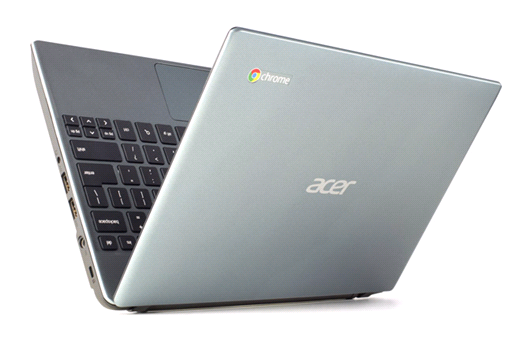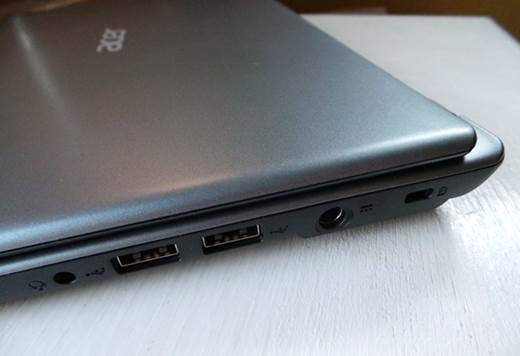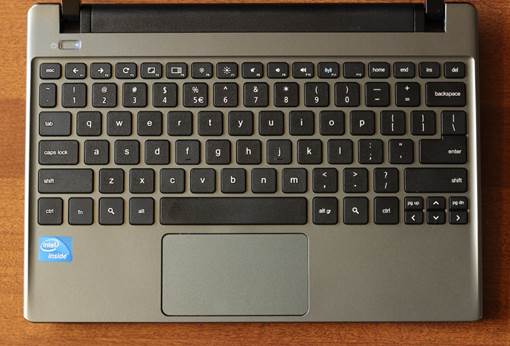For many, the Chrome OS is an
essential spice - you really have to live with it a few days to learn it.
Although it's not for everyone, it is an attractive option once you understand
the idea. Certain simplicity with cloud-based computing becomes clear once you
start using a system designed to do just one good thing - what most people do:
surf the Web
It had just been over a month since Google
introduced a gorgeous and affordable $249 Samsung's Chromebook. They made us
surprised several days later with an even cheaper system, $199 C7 Acer's
Chromebook. At first glance, the two laptops are very similar, both in purpose
(based on cheap cloud computing) and in specifications (11.6inch screen,
dual-core CPU, 2GB of RAM), but there are many differences inside the shell.
Samsung's product has slender shape, 6.5 hours of battery life and an
attractive price through a fully integrated and fanless design based on ARM,
while Acer has a more conservative approach - stuffing components which were
standard mass produced such as 2.5-inch hard drive, small outline memory
modules, mini-PCIe WiFi card, and Intel Celeron processor in a frame look like
traditional netbook. Can being $50 cheaper make up for the lack of C7's
attractiveness and short battery life of 4 hours? Are there other compromises
in performance and build quality (if any) which were given to lower the price
like this? More importantly, can this low-end Chromebook suit you? Let's find
out.
Look and Feel

Acer's
Chromebook looks like a low-end netbook
While $249 Samsung's Chromebook is built
with certain purposes and is inherited most of the beautifully designed
properties of its larger, faster and more expensive, sibling, Series 5550, $199
Acer's Chromebook looks like a low-end netbook. In fact, beside Chrome logo and
those exclusive labels of the operating system, you will be hard to tell the
difference between C7 and its twin, 11.6inch Acer Aspire V5. The build quality
and materials are the same with other low-end Acer systems that we have come
across - which had lot of cheap plastic molding material - making this laptop
look sturdy but not very elegant. If Samsung Chromebook evokes MacBook Air11
inch, C7 is just a pure utilitarianism operational. Besides those obvious
aesthetic differences, Acer Chromebook is also thicker (1 inch vs. 0.7-inch)
and heavier (3 pounds vs 2.4 pounds).
Screen lid and keyboard tray are painted in
iron-gray while the bottom shell is made from black raw plastic and the bevel
surface of the screen is black gloss. Strangely, each of these different
surfaces attracts fingerprints at many different levels. Acer's brand is marked
below the 11.6-inch glossy screen and in the middle of the lid. Chrome logo is
embossed in the top left corner of the lid - it really is a sticker that began
to fall off just a few minutes after we unboxed C7. You will find a webcam and
a microphone above the screen and the power button with embedded green LED
above the left side of the keyboard.

10/100
Ethernet jack, VGA and HDMI output, along with a USB 2.0 port
Speaking of which, the keyboard use black island-style
keys but has different layout with other Chromebooks, which is very difficult
to understand (we'll talk in more detail later). On the left-side is the set
of a 10/100 Ethernet jack, VGA and HDMI output, along with a USB 2.0 port,
while on the right-side has a Kensington lock, power connector, two USB 2.0
ports and a 3.5mm standard headphone jack. In the front, there is one SD card
slot on the left and two status LEDs blue/orange (sleep and charge) on the
right. 4-cell Li-ion battery removable slide into the back of the system and
is tightened through a sliding locking mechanism which is accessible from
below.

A
Kensington lock, power connector, two USB 2.0 ports and a 3.5mm headphone jack
Flipping the Acer Chromebook over revealed
few air vents and grids for fans and set of speakers. What is more interesting
is the bottom shell is mainly covered by a plastic door which was fastened by a
single Phillips screw that located under the warranty seal. Opening this door provides
access to the 7mm-thin 2.5-inch SATA hard drive (320GB/5400rpm) was
manufactured by Seagate, two DDR3-1066/1333 slots SODIMM (one of them has 2GB
RAM) and mini -PCIe 802.11a/b/g/n Atheros WiFi card (but no Bluetooth).
Combined with the Ethernet jack, VGA output and additional USB 2.0 port make C7
a lot more tinker-friendly than the Samsung's Chromebook. In fact, resourceful
hackers have dual boot Chrome OS and Ubuntu 12.04 on this laptop - we're sure
that Windows 8 will not so far behind.
Keyboard and trackpad

The
keyboard use black island-style keys
We have been disappointed with the quality
of the keyboard and trackpad of the $249 Samsung's Chromebook, which seems to
be taken directly from the more expensive Series 5550. The C7 fail shorts in
comparison - the keyboard and trackpad are quite good, but we can’t type this
entire review on $199 Samsung's Chromebook.
Firstly, the keyboard different from the
standard Chromebook layout by removing the power button (it is located
separately) and including caps-lock button (instead of the search key).
Secondly, it is full of ruins keys (such as Home, End, Ins, Del) which is too
small to be useful and in some cases (such as the PgUp / Dn), interfere with
the cursor keys, which quickly makes editing document extremely frustrating.
Thirdly, the Ctrl and Alt keys are too small and isolated from each other on
the left, while the Alt key is lost on the right (replaced with Alt Gr). Once
you have overcome this obstacle, it's a serviceable if somewhat mushy Chiclet keyboard.
Acer's trackpad almost match with
Samsung's. 1-finger tracking and the 2-finger scrolling work as expected, but
pressing to click requires a lot more force, which becomes tiring after using
C7 for a while. Of course, the tap-to-click is available in settings, but we
prefer the tactile feedback of a good calibration switch.